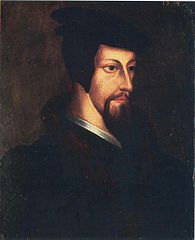Presbyterian History
The Reformation
Movements to "purify" the institutional church have existed since the very beginning. It is possible to see all of the ecumenical councils as responses to disagreements about what the church should be or how it should act. In the 16th Century, however, these disagreements with the church leaders in Rome merged with a growing sense of nationalism to create what we now call the Protestant Reformation.
In 1517, Martin Luther posted a list of 95 theses or debating points on a church door in Wittenberg, Germany These debating points related to his disagreements on the church's sale of indulgences (documents stating that the Pope would forgive a specific sin for the bearer of the certificate). At first the response had been like any other internal disagreement. But it escalated dramatically.
During this time several theologians and distinct ways of understanding the Church emerged. Most significant for our branch of the Church were John Calvin, a Frenchman working in Geneva, Switzerland; Ulrich Zwingli, in Zurich, Switzerland; and John Knox a Scotsman who studied with Calvin and returned to preach in Edinburgh, Scotland. Eventually the Reformation movement coalesced into two main theological streams with followers of the Luther's teaching in Scandinavia and Germany and followers of Calvin's teaching in Scotland, England, Holland, and France.
John Calvin

Calvin's ideas, rather than bringing about the reforms he sought, elicited a wave of anti-Protestant sentiment that forced him to flee for his own safety. During the next few years, he sought refuge in various cities, most notably Basel, Switzerland. It was also during this period that he began work on his Institution de la Religion Chrétienne (The Institutes of the Christian Religion), the voluminous work that would consume a good deal of his energy for the next three decades.
During Calvin's flight, he happened to pass a night in Geneva with a man named Farel. Farel attempted to persuade Calvin to remain in Geneva working in support of the Protestant cause there. Reluctantly, Calvin agreed. In 1541, pro-Protestant forces gained control of the city. For the remainder of his life, Calvin stood as the dominant figure in a Geneva that became a point of refuge for persecuted Protestants from all over Europe.
Despite Calvin's work in Geneva, his chief claim to an enduring legacy is found in his theology, which has been greatly influential in many Protestant denominations. The primary tenets of Calvinism include a belief in the primacy of the scripture as an authority for doctrinal decisions, a belief in predestination, a belief in salvation wholly accomplished by grace with no influence from works, and a rejection of the episcopacy. Along with The Institutes, he also produced commentaries on the books of the Bible.
Text © 1997, Mark Browning. Used with permission.
From the Christian Classics Ethereal Library
In time the hierarchy in Rome reformed the worst of the abuses in what is known as the Counter-Reformation or the Catholic Reformation, but by then the rupture was complete.
We now see the Reformation as a success for the theological inquiry it spawned and the public interest in spiritual things it encouraged; however, it was a terrible blow to the larger mission of the church and a source of much division, hatred, and violence. The Thirty Years War and the greatest abuses of the Inquisition have their roots in this division.
As Presbyterians we now see our differences with other denominations not as superiorities but as gifts we give to the larger church. Our distinctive theology and form of government are examples we can provide the larger church of a way of being the church that is more inclusive and less hierarchical. Additionally, we gladly receive the gifts of other denominations' distinctives in theology, liturgy, aesthetics, forms of ministry and such. These denominational distinctives are valuable. They are sometimes complementary and sometimes corrective but hopefully the conversation among them makes us better able "to glorify God and enjoy God forever." (Westminster Catechism)
Presbyterians in the United States
1630s |
First Presbyterian churches organize in the colonies. |
1683 |
Francis Makemie, the "Father of American Presbyterianism," arrives from Ireland. |
1706 |
First presbytery in the American colonies organizes in Philadelphia. |
1789 |
First Presbyterian General Assembly meets in Philadelphia. |
1807 |
First African-American Presbyterian church organizes in Philadelphia. |
1837 |
Elijah Lovejoy, minister and abolitionist publisher, dies while defending his printing press against a pro-slavery mob in Alton, Illinois. |
1861 |
The General Assembly pledges loyalty to the Federal government. Southern commissioners withdraw and form the Presbyterian Church in the Confederate States of America. |
1930 |
The PCUSA's constitution is amended to allow women to be ordained elders. |
1956 |
First woman minister ordained, Margaret Towner. |
1964 |
First African-American moderator of a General Assembly, Edler Hawkins. |
1972 |
First female moderator of a General Assembly, Lois Stair. |
1983 |
Two largest American Presbyterian denominations, reunite after 122 years. |
1986 |
First Native-American woman ordained, Holly Haile Smith. |